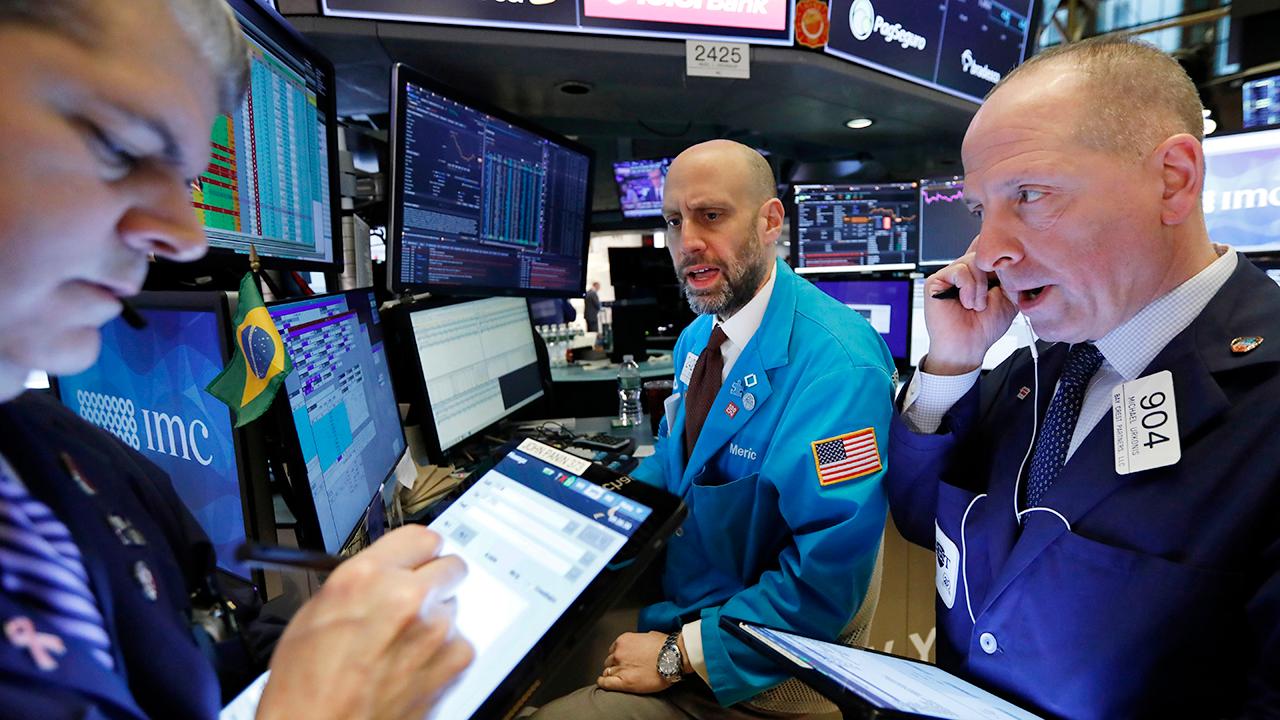The wildly popular trades behind the market’s swoon and surge
Record options trading and momentum bets are spurring volatility
Investors are trading stock options and chasing fast-rising shares at record rates, activity that’s expected to jolt markets through the coming election.
A surge in options trading targeted at giant tech stocks by both small and large investors is magnifying the market’s ups and downs. Investors are also simply buying shares that are going up, a strategy that can create its own wild swings in the market.
“It’s really exploded to a level I haven’t seen,” said Brent Kochuba, founder of data firm SpotGamma, which tracks derivatives positioning.
FOX NEWS POLL: BIDEN-TRUMP AT 5-POINT RACE IN POST-CONVENTION POLL

Traders, some in medical masks, work on the floor of the New York Stock Exchange (NYSE) on March 20, 2020 in New York City. (Photo by Spencer Platt/Getty Images)
The two strategies show no signs of fading despite big declines in the past week. Taken together, they will likely continue boosting volatility in markets already grappling with an uncertain economy, the coronavirus pandemic and a presidential election that may not have a conclusive result for days or even weeks.
Adding to the mix is rising interest among Asian investors in stocks like Tesla Inc. The new money can make options and momentum strategies self-fulfilling, drawing in additional money hoping to cash in on the gains.
The volume of trading in single stock options recently topped the volume of regular shares for the first time, according to a Goldman Sachs analysis of notional shares and options traded. As of the end of August, single stock options volume made up more than 120% of the volume of shares, up from around 40% three years ago.
It has been a record year for options volumes. So far in September, about 35 million single stock and ETF options contracts have changed hands on an average day, up about 92% from the same month last year, according to Henry Schwartz, senior director of market intelligence at Cboe Global Markets.
Options traders tend to thrive on market volatility, which roared back at the start of September. The S&P 500 recently logged its biggest three-day percentage decline since June, while the tech-heavy Nasdaq Composite recently entered a correction—defined as a 10% drop or more from a recent high—in record time, snapping an extended period of calm.
Small investors bought call options with roughly $500 billion of notional value in August, says Benn Eifert, managing partner of $125 million hedge fund QVR Advisors, citing data from the Options Clearing Corp. That’s five times the previous monthly high for these smaller accounts, reached in early 2018.
“The trading of options over the last six months, particularly by small traders, is quite incredible and off the charts,” says Mr. Eifert, whose firm is active in options markets. “It’s a steamrolling trend that’s having a very meaningful dynamic for markets.”
Option buying is important partly because it forces Wall Street banks, which sell options to investors, to hedge their positions, potentially accelerating trends in either direction. When brokers sell bullish call options to investors, for example, they will buy shares and derivatives to protect themselves if the market soars. That act itself can drive up shares.
“When you do get rallies and selloffs, [options activity] forces the Street to chase those moves,” said Stuart Kaiser, head of equity derivatives research at UBS. “It can exacerbate moves in both directions as the Street adjusts their hedging.”
Some of the options trades have been giant, like SoftBank Group Corp. ’s $4 billion bet on big tech stocks. They have also been tiny, with bullish trades of 10 options contracts—the kind that are less expensive and more likely to be tapped by individual traders—rising in recent months. But since many investors are targeting the same stocks, their impact can be big.
Stock options give investors the right, though not the obligation, to buy or sell a stock at an agreed upon price. A “call” option allows an investor to buy shares at a certain price, and as such can be a bullish bet, while a “put” option lets the owner sell a share at an agreed-upon price.
Investors often turn to call options to make a bigger bet than if they simply bought shares. That’s because options allow them to put down a relatively small sum for a big return if their wagers prove right. Losses can result from call options when shares fall.
Investors have rushed into options contracts tied to stocks that have soared the most this year. The number of options contracts outstanding for Apple Inc., Facebook Inc., Google-parent Alphabet Inc., Amazon.com Inc. and Microsoft Corp. have jumped since late August, with call option interest making up 70% of the growth, according to UBS data. These stocks are up between 13% and 69% this year.
Investors turned so bullish on stocks like Tesla and Apple that it cost more to bet on gains in the stock than hedge against declines, a rare occurrence.
FACEBOOK, APPLE LEAD CORPORATE AMERICA TITANS BOOSTING VOTER TURNOUT
Asian investors have emerged as new buyers of Tesla and tech stocks, says David Bailin, global head of investments for Citigroup’s private bank, which caters to wealthy clients. Those clients increased their net exposure to technology companies by 12% over the past year, Mr. Bailin says. Asian investors also are becoming more optimistic about Tesla because of its new Chinese factory and a rising interest in electric cars, Mr. Bailin says.
More investors are simply chasing momentum—they buy stocks that are rising and sell those that are falling—activity that’s also amplifying the markets’ moves. Exchange-traded funds trading based on momentum have seen their assets under management jump to about $18 billion this year, a 16% increase from last year and the highest level of the past decade, according to FactSet data as of Aug. 31.
Data from Société Générale showed that individual investors using the Robinhood Markets Inc. brokerage have favored shares that have risen the most over the past three months over those that have lagged behind. They dramatically increased their holdings of such winners starting in March.
Meanwhile, trading models of quantitative funds and so-called commodity trading advisers told many of these investors to chase these stocks over the summer, traders say. When shares go up and momentum is positive, many trading models signal that it’s time to buy stocks, says Rob Arnott, founder of Research Affiliates LLC, which manages $146 billion.
Just over a week ago, though, as tech and other expensive shares began showing signs of weakness, momentum traders went from buyers to sellers, says Nikolaos Panigirtzoglou, a global market strategist for JPMorgan Chase.
CLICK HERE TO READ MORE ON FOX BUSINESS
But individuals trading options seemed undeterred by the selloff. “Small option traders saw last week’s correction as an opportunity to add to their call option buying, especially on individual equities,” Mr. Panigirtzoglou wrote in a note to clients.




















